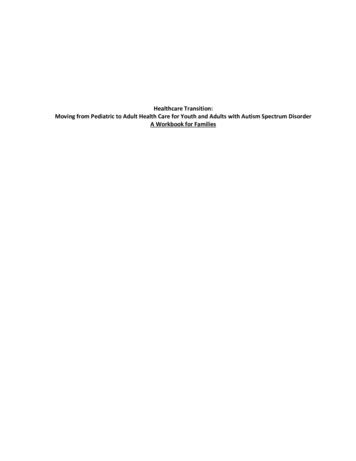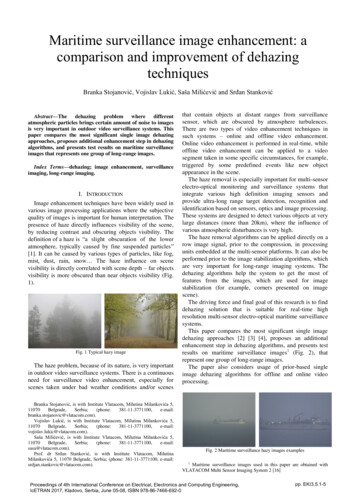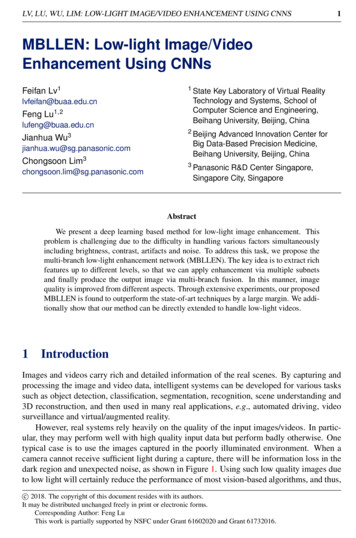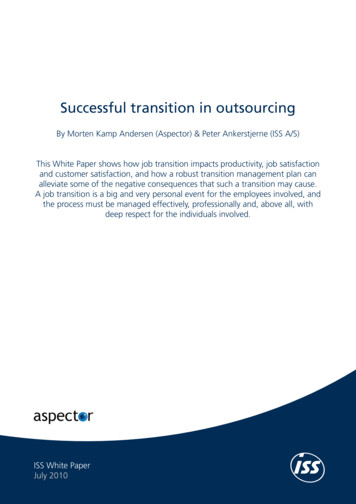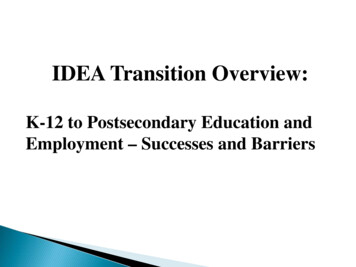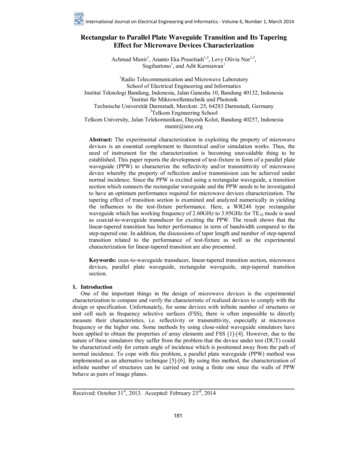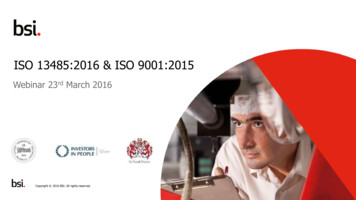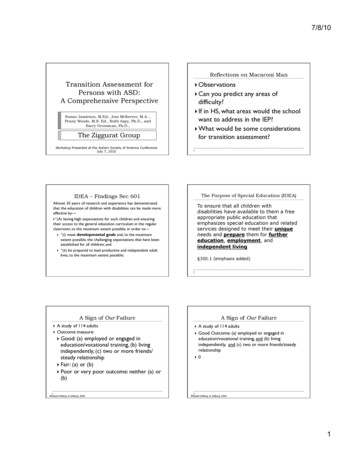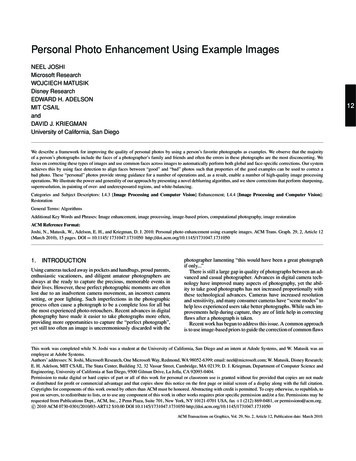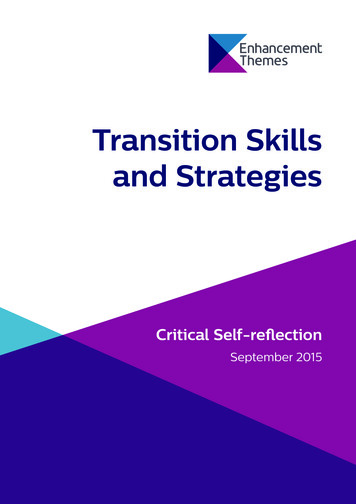
Transcription
Transition Skillsand StrategiesCritical Self-reflectionSeptember 2015
IntroductionProject leader: Dr Ming Cheng, University of Glasgow (now University of Wolverhampton)Project team members: Dr Gayle Pringle Barnes, Professor Christine Edwards, Dr ManousosValyrakisResearch assistant: Roxana CorduneanuThis report explores the concept of critical self-reflection as one important transition skill thatstudents would benefit from developing during their university studies. It begins with adiscussion of the different terms that have been used interchangeably with critical self-reflection,thereafter offers a definition of what is meant by critical self-reflection, and then presents anoverview of why critical self-reflection is important in the context of student transitions.The importance of critical self-reflection at key transition points is also discussed. As in the indepth exploration of self-efficacy (Report 4), transition points are viewed as: pre-transition,shock and adjustment and progression. Finally, the report recommends a number of practicalstrategies which can help students develop their reflective skills. Also identified are the potential,challenges in developing critical self-reflection.Understanding critical self-reflectionCritical self-reflection is thought to play an important role in facilitating student transitions(Brockbank and McGill 2007) and is closely linked with the development of higher-order thinkingskills (Fisher, 2003). Different terms have been used to interpret the concept, including'self-monitoring', 'self-regulation', 'reflection-in-action' and many others which are usedinterchangeably (Rogers, 2001). Critical self-reflection refers to becoming aware of ourpresuppositions and challenging our established patterns of thinking (Jarvis et al 2003;Mezirow, 1990). In order to provide a clearer understanding of this concept, the report will firstdefine the term 'reflection' as well as ‘critical self-reflection' to illustrate the differences betweenthe two.ReflectionThe literature suggests that the roots of the term reflection can be traced back to John Dewey(1933-93) and Donald Schön (1983, 1987 and 1991). Dewey (1933-93, page 9) definesreflection as action based on 'the active, persistent and careful consideration of any belief orsupposed form of knowledge in the light of the grounds that support it'. Similarly, Schön (1983)interprets reflection as a process in which a person tries to deal with and make sense of 'somepuzzling or troubling or interesting phenomenon' while simultaneously reflecting on 'Theunderstandings which have been implicit in his action, understandings which he surfaces,criticises, restructures, and embodies in further action' (page 50). According to this definition,a reflective student is one who examines his/her practices, comes up with some ideas as how toimprove his/her performance and puts these ideas into practice. Schön (1983) refers to thiscycle as appreciation, action, and re-appreciation.Moreover, there are two types of reflection: 'reflection in action' and 'reflection on action'.Reflection in action takes place while we are involved in a situation, during which we becomeaware of what we are thinking, feeling and doing. In contrast, reflection on action involves astepping back from the situation, meaning that it takes place some time after the situation hasoccurred. Thus, the latter of the two can be the more challenging and time consuming type of1
reflection (Schön, 1983). Whatever the type of reflection, the outcomes of the reflection processcan be a new understanding of the situation at hand, an awareness of how emotions areinvolved in the situation, some form of action, and the recognition that further exploration andlearning are needed (Mann et al 2009; Moon 2005).Critical self-reflectionCritical self-reflection refers to the process of questioning one's own assumption,presuppositions, and meaning perspectives (Mezirow, 2006). Since transitions involvesnavigating changes where a person moves from one stage to another, critical self-reflection maybe an important skills for facilitating transitions by allowing individuals to reassess or alterexisting life structures (Bee 2000, page 434). According to Stein (2000), critical self-reflection isdifferent from other types of reflection since this involves individuals having not only anunderstanding of the assumptions that govern their actions, but questioning their meaning anddeveloping alternative ways of acting.In the context of student transitions, critical self-reflection represents a way in which learnersstep back from their learning experience and engage in deeper and more meaningful learning(Moon 1999). Reflecting critically on the impact and origin of one's own assumptions,positioning, feelings, and behaviour all represent the first steps in this process (Finlay 2008).The role of critical self-reflection in student transitionsThe literature suggests that critical self-reflection can help facilitate student transitions in threemain ways. Firstly, when entering university, one of the most important challenges that studentsface is the fact that they have moved away from instructor-based learning to a moreself-directed, independent learning style (QAA 2015). In addition, students need to be able todemonstrate deep learning in order to attain high levels of academic achievement(Entwistle 2000). If students are encouraged from the early stages to become more criticallyreflective on what they learn and, in particular, how their learning habits need to be altered to fitthe new academic environment, they may be able to move more easily from one learning styleto another (Brookfield 2009; Leijen et al 2011).There is considerable agreement that the level of reflection attained by a learner is a function ofhow much the learner's existing schemas or cognitive structures are changed (Xie et al 2008).For instance, Moon (1999) identifies learning as a continuum ranging from the stages of'noticing; ' 'making sense; ' 'making meaning; ' 'working-with-meaning' to 'transformativelearning' (page 139). The first two phases represent surface learning, where the student simplymemorises new concepts. However, from stage three (‘making meaning') onwards, students areengaged in deep learning by actively integrating new ideas into their cognitive structures.Students who are reflective will be able to relate new understandings to previous knowledge,take a critical overview of the self and broaden their thinking into a larger (such as sociopolitical)context, thus moving to a higher-order learning stage (Moon 1999).As for the relationship between critical self-reflection and self-directedness, both Brookfield(1993) and Evensen et al (2001) argue that having learners exercise control over theireducational decisions is crucial for the development of their independent learning. In turn, thisappears to be correlated with higher academic performance and motivation (Zimmerman andMartinez-Pons 1986; Zimmerman 2008).2
Another change during the transition to university is related to the complex environment thatstudents encounter, that is the vast, dynamic university establishment (Lairio et al 2011).In emotional terms, the transition to university may even be compared to a culture shock, sincestudents often fail to recognise and meet the new expectations. The transition to university israrely a simple, straightforward process. As Lairio et al (2011) suggest, students encounterdifficulties in committing to university culture, experience a loss of a previously familiar studentidentity and have to cope with motivation problems related to competing academic andnon-academic demands. Numerous studies have shown that critical self-reflection can helpstudents manage anxiety and stress, and develop realistic expectations concerning their newacademic demands or changes in their social life (Brouillette et al 1999; Morisano et al 2010;Murray‐Harvey 1999). For instance, Murray-Harvey (1999) investigated the coping strategies oflow-stress and high-stress students and showed that the low-stress group employedself-reflection strategies much more than the high-stress group. Similarly, Morisano et al (2010)reported a positive correlation between self-reflection and setting realistic goals, and that in turn,goal setting is related to improvements in both academic performance and subjective wellbeing.Finally, on the transition from university study to the working environment, students need tobe able to reflect on their professionalism and professional identity (Lairio et al 2011).Professional identity can be defined as how an individual sees their own place and part insociety's activity and division of labour (Lairio et al 2011). In line with this definition, reflection onprofessional identity includes a broad look at one's own strengths and actions in relation to work(Archer 2008; Christie et al 2008). Engaging in this type of reflection can increase awareness ofone's priorities, and can provide insight into selecting a profession (O'Regan 2010). In addition,the development of transferable skills during employment (for example communication skills,problem solving, analysis and teamwork skills) could be enhanced if critical self-reflectionreceived greater emphasis during undergraduate and postgraduate studies (Marginson 1994;Crebert et al 2004).Importance of critical self-reflection at key transition pointsThe literature reveals that critical self-reflection is needed at all transition points(Lairio et al 2011; Booth 2001), from the last few weeks before entering the universityenvironment to graduation and progression into employment. The initial stages of the transitionprocess are marked by feelings of excitement and fear of the unknown, where students envisiona life with opportunities for personal, social and intellectual growth, but do not yet have directcontact with the university (Burnett 2007). Then, the student enters a stage of ‘Culture Shock'(according to the U-Curve Theory of Adjustment, see Report 1), where he/she experienceschanges in their academic environment and social life, usually associated with higher levels ofanxiety and stress (Denovan and Macaskill 2013; Thurber and Walton 2012). The third phase ofthe process according to this model is known as the ‘Adjustment' stage, where the studentacquires new learning routines, develops a sense of community with peers, and starts tofunction effectively in the new environment (Risquez et al 2008). Finally, during stages of‘Progression', the student experiences another transition such as to further education oremployment (Burnett 2007) when they will need to think about their professional identity andcareer development.3
The following examines the role of critical self-reflection at each transition stage.The pre-transition stageAt the initial stages (pre-transition), self-reflection can help the student's self-management ofexpectations, as students who are able to assess their skills and motivation are more likely tounderstand and cope with the demands of the new academic environment. It is especially at thisinitial stage of studies that negative learning experiences can be the result of difficulties incommitting to university culture as well as to the large amount of independent work, incorrectsubject choices, and new teaching methods (Lairio et al 2011).The shock and adjustment stagesAt the culture shock and adjustment stages, critical self-reflection becomes even moreimportant, as students will need to be able to transcend past habits and understandings,to develop a more independent and critical evaluation learning style as well as adapt to a newsocial life (Booth 2001). It is argued that through engaging in critical self-reflection, studentsbecome more sophisticated learners of their subject areas as well as more self-aware andconfident learners in general. This is because critical self-reflection encourages students notonly to recognise the capabilities they already possess, but also increases their capacity tobecome more receptive to theoretical perspectives and new ideas, as well as enhances theirability to critique evidence. Overall, critical self-reflection may well improve academicperformance (Booth 2001).The progression stageJust as in the adjustment stage, towards the end of the transition process (the progressionstage), students who engage in critical self-reflection will be able to identify and articulate theskills developed during their study. This can lead to students engaging in strategies such assetting goals for continuing personal, professional and career development.A recent report by the University of Bolton (2014) highlighted that students have manyopportunities to enhance their employability skills during their studies. Examples include taskssuch as writing assignments, reports and dissertations, taking part in presentations anddebating, as well as critically reviewing information. Reflecting on what they have learned fromthese activities and recording their skills and achievements can help students develop theirself-knowledge. This also provides a bank of evidence for students to draw upon tocommunicate to an employer at the application and interview stages of seeking employment(University of Bolton 2014).Practical strategies to support the development of critical selfreflectionConsiderable research (Arter and Spandel 1992; Fisher 2003; Jones 2004; Moore 2004;Rodgers 2002; Spalding and Wilson 2002; Yinger and Clark, 1981) indicates that there are anumber of learning and teaching practices which can help to develop and enhance students'critical self-reflection skills. For example the use of learning journals, debates, reflective writing,peer review exercises, peer coaching/mentoring, personal development planning, studentportfolios) have all been recommended. The following section in this report focuses on the4
practices of learning journals, peer review exercises and student portfolios, since these are themost widely-cited in the literature.Learning journalsLearning journals are written records, which students create as they think about the conceptsthey have learned, the critical incidents involved in their learning and the interactions they havehad with other students or tutors (Thorpe 2004). According to Luidens (1997, page 141),‘writing is a manifestation of thinking', and because students need to manipulate and transformtheir knowledge before they can present it in a written form, learning journals are suggested tohave the ability to facilitate new understandings (Yinger et al 1981). In addition, reflective journalwriting can also enable students to critically review the processes of their own learning andbehaviours, and to change their learning strategies as and when needed (Gleaves et al 2008).The literature reports a positive association between journal keeping and learners' cognitiveskills (McCrindle and Cristensen 1995; Stephien et al 1998). For example, in a study byMcCrindle and Christensen (1995), forty undergraduates in a first-year biology course wererandomly assigned to a learning journal (experimental) group or a control group. The resultsshowed that students in the experimental group used more cognitive strategies during alearning task compared to those in the control group. In addition, students who kept learningjournals showed more sophisticated conceptions of learning and greater awareness of cognitivestrategies. They also performed significantly better on the final examination for the coursecompared to students who had not used learning journals.Learning journals are widely adopted in practice in many institutions, albeit mostly on anon-compulsory basis. For instance, the University of Portsmouth provides a reflective journaltemplate on their website, as well as links to reflective writing guides. Furthermore, many otheruniversities provide useful information to support students to develop reflective writing skills(University of Bradford 2015; University of Manchester 2015; University of Reading 2015).It is useful to note that many degree courses with The Open University have requirementswhere student learning journals are mandatory as part of assessment submission. Entries arenot marked only non-submission leads to loss of marks.In spite of the advantages of journal writing as presented above, some studies have alsoshown that students can experience a number of challenges in keeping a reflective journal.Some examples include a loss of enthusiasm for the task over time, frustration and uncertaintyabout what to write, and the solitary nature of writing (Bain et al 1999 and Kerka 1996).Moreover, in some cases students might simply document concrete observations of theirexperiences, without demonstrating any critical reflection (Kerka 1996). These studies suggestthat academics will sometimes need to provide additional support to students while they arewriting learning journals. They could, for instance, provide guidelines regarding content andformat, suggest a theme for reflection, and give clear explanations of the purpose for thereflective exercise (Woodward 1998). In addition, academic staff could also provide studentswith feedback and encouragement throughout the process in order to facilitate further reflection(Dye 2005).Peer reviewPeer review is considered to be another important tool for developing critical self-reflection skillsin students (Dochy et al 1999). Encouraging students to give each other regular feedback ingroup meetings helps students become familiar with reflective practices (Moon 1999 andBoud 1999). In peer review, students reflect on their own and others' performance of group5
tasks. Reviewing the performance of their peers (strengths, weaknesses and areas forimprovement) builds the students understanding of the principles of effective group processesand allows them to think about their own performance or approaches (Moon 1999).Research has shown that students who engage in such self-monitoring exercises where theyevaluate each other's performance (rather than rely soley on teachers for feedback) becomebetter at self-regulated learning (Butler 2002; Alvi and Gillies 2015). As Moon (1999) explains,'working with others can facilitate learners to reflect and can deepen and broaden the quality ofthe reflection so long as all the learners are engaged in the process' (page172).Although peer assessment can be used as one tool to facilitate critical reflection, we need to beaware that students in the transition stage might lack experience in such methods, so peerassessment is probably best introduced as a formative, rather than summative device(Booth 2001, page 501). As too many new types of assessment may lead to resistance, peerassessment might be more likely to gain acceptance once students have become morecomfortable with the notion of reflective learning (Booth 2001). The role of academic staff is alsoimportant here, as they would need to offer students significant support as they adjust to peerassessment.Student portfoliosStudent portfolios represents a powerful reflective tool, as they can help students keep track oftheir development (Zubizarreta 2008). A student portfolio is defined as a collection of studentwork that illustrates the student's efforts, progress, or achievement in given areas(Arter and Spandel 1992).A number of universities that have adopted the use of learning portfolios. The University of NewSouth Wales (2015), for example, have developed the UNSW Student Portfolios Site, wherestudents can record their experiences and achievements relevant to a number of graduateattributes, such as communication, teamwork and problem solving. An exercise on reflection onwhat has already been achieved can enable students to plan how they will go about developingfurther desired attributes.Similarly, the University of Glasgow (2015) have developed the Graduate Skills Programme(GSP), where students build an electronic portfolio illustrating the skills they have developed intheir university years. Students are encouraged to write about four different aspects of theiruniversity experience: (1) academic skills related to aspects such as writing a dissertation orattending academic skills workshops; (2) extra-curricular activities related to aspects such asstudying abroad or being part of a student society or club; (3) jobs and careers, wherenetworking activities with employers at career fairs can be discussed and/or the creation of aprofessional LinkedIn profile; and (4) work-related learning, where students can discuss theirsummer internships and placements. Students can choose to complete either element of theire-portfolio (or all), articulate the skills they have developed and reflect on their future careerobjectives. As an incentive, the University offers an employability award to students whosuccessfully build this portfolio.The intrinsic merit of learning portfolios is that they involve students in the process of reflection,encouraging them to think about their achievements and communicate a sense of the learningexperience as a coherent, unified process (Zubizarreta 2008). In other words, the value ofportfolios lies not only in engaging students to collect representative samples of their work forassessment or career preparation, but also in addressing vital reflective questions such as6
'what have I learned?', 'why did I learn?', 'how did I learn?'. In addition, most student portfoliosinvolve an element of personal development planning (that is creating an action plan forpersonal development), which has also been shown to enhance critical self-reflection(Whittaker 2008).Challenges in promoting critical self-reflectionDespite the strong arguments for developing skills in critical self-reflection, there is a concernthat critical reflection might not always be a desirable activity (Gardner et al 2006). Some peoplereact to the term 'critical', as it evokes a focus on the negative aspects of an interactionor experience (White et al 2006). For others, reflective practice is an activity that isWestern-oriented and cannot be applied to other cultures (Gardner et al 2006) or is not furtherencouraged or supported in the workplace. While most research about critical reflection is of aqualitative, self-reflective nature, there is a relative lack of research on the effectiveness ofreflection, the outcomes of reflection, as well as the different methods and processes ofreflection (White et al 2006). In addition, Yip (2006) points to several case studies where criticalsupervisors forced students to reveal their weaknesses in a way that was destructive, harmfuland unprofessional.Moreover, being a critical reflector can be a challenging task as it involves 'de-centring' oneself(Bolam et al 2003) and stepping back from one's own practices and 'visualising oneself overtime and place' (Stronach et al 2007, page 180). Undertaking such activities requires a studentto invest time in contemplation and exploration of alternative perspectives. This could detractfrom their learning of technical skills or subject knowledge, which are likely to be the student'spriorities during their study. Previous research has also indicated that reflection is an effortfulaction and students find it difficult to engage in reflection over extended periods of time withoutexternal support (Harri-Augstein and Thomas 1991). It has been found that most universitystudents are involved in 'quasi-reflective' thinking as their reflections usually stop at the lowerlevel (King and Kitchener 1994).Brockbank and McGill (2007) therefore argue that self-reflection on its own is not sufficient topromote critical reflective learning, as a radical shift in both teaching methods and teaching andlearning relationships has to take place. Such learning needs to be promoted through a processof reflective dialogue between teachers and learners as well as between students themselves(Fisher 2003). This is because the process of critical self-reflection is closely linked with anindividual's active engagement. In other words, if students treat reflective activities as extrawork, it may be because they do not see its relevance to their learning or because they are notmotivated. Academic staff, therefore, need to encourage and motivate students to get engagedwith critical self-reflection. Otherwise, students will tend to comply with the minimumrequirements without learning from the process itself (Mann et al 2009; Rogers 2001;Moon 2005).ConclusionThis report has conducted a detailed review of the research evidence for the role of criticalself-reflection in facilitating student transitions. The evidence reviewed in this report suggeststhat critical self-reflection is a key skill, which students would benefit from developing. Numerousresearch studies suggest that that the act of critical self-reflecting can help students make senseof not only what they have learned but also why they learned it, and how that particularincrement of learning took place. Moreover, there is strong support from a number of studies7
indicating that critical self-reflection can help deepen learning, especially in terms of helpingstudents adapt to a new learning style and to a new environment as well as thinking about thenew stages in their academic or professional development. Finally, the role of criticalself-reflection at each transition stage (pre-transition, shock, adjustment and progression wasalso discussed. A number of practical strategies for developing students' reflective skills werealso recommended.8
ReferencesAlvi, E and Gillies, R M (2015) Social interactions that support students' self-regulated learning:A case study of one teacher's experiences, International Journal of Educational Research, 72,pp 14-25.Archer, L (2008) Younger academics' constructions of 'authenticity,' 'success,' and professionalidentity, Studies in Higher Education, 33(4), pp 385-403Arter, J A and Spandel, V (1992) Using portfolios of student work in instruction and assessment.Educational Measurement: Issues and Practice, 11(1), 36-44.Bain, J D, Ballantyne, R, Packer, J and Mills, C (1999) Using journal writing to enhance studentteachers' reflectivity during field experience placements, Teachers and Teaching: Theory andPractice, 5, pp 51-73Bee, H (2000) The journey of adulthood. Upper Saddle River. NJ: Prentice HallBooth, A (2001) Developing History Students' Skills in the Transition to University, Teaching inHigher Education, 6(4), pp 487-503Bolam, B, Gleeson, K and Murphy, S (2003) 'Lay person' or 'Health expert'? Exploringtheoretical and practical aspects of reflexivity in qualitative health research, Forum: QualitativeSocial Research 4(2), Art. 26Boud, D (1999) Avoiding the traps: Seeking good practice in the use of self-assessment andreflection in professional courses. Social Work Education, 18, pp. 121–132.Brockbank, A and McGill, I (2007) Facilitating Reflective Learning in Higher Education(2nd edition) Buckingham: SRHE/Open University PressBrookfield, S (2009) The concept of critical reflection: promises and contradictions, EuropeanJournal of Social Work, 12(3), pp 293-304Brouillette L, Clinard L and Ariav T (1999). Coaching for teacher efficacy. Paper presented atthe Third International Conference on Teacher Education, Beit Berl College, IsraelBurnett, L (2007) Juggling First-Year Student Experience and Institutional Change:An Australian Example, In: The 20th International Conference on First Year Experience. Hawaii,pp. 1-33Butler, D.L. (2002) Individualizing instruction in self-regulated learning, Theory into Practice,41 (2), pp 81-92Crebert, G, Bates, M, Bell, B, Patrick, C-J and Cragnolini, V (2004). Developing generic skills atuniversity, during work placement and in employment: graduates' perceptions, Higher EducationResearch & Development, 23(2), 147-165Christie H, Tett L, Cree V E, Hounsell, J and McCune V (2008) 'A real rollercoaster ofconfidence and emotions': Learning to be a university student. Studies in Higher Education,33(5), pp 567-5819
Denovan A and Macaskill A (2013) Developing autonomous learning in first year universitystudents using perspectives from positive psychology. Studies in Higher Education, 38 (1), pp.104–123.Dewey, J (1933/1993) How We Think: A Re-Statement of the Relation of Reflective Thinking tothe Education Process. DC Heath, & Co: BostonDochy F, Segers M and Sluijsmans D (1999) The use of self-, peer and co-assessment inhigher education: a review. Assessment and Evaluation in Higher Education, 24(3), pp.331-351.Dye, D (2005) Enhancing Critical Reflection of Students During a Clinical Internship Using theSelf-S.O.A.P. Note. The Internet Journal of Allied Health Sciences and Practice, 3(4)Entwistle, N (2000) Promoting deep learning through teaching and assessment: conceptualframeworks and educational contexts. Paper presented at the TLRP Conference, Leicester,November 2000. Available at: n D H, Salisbury-Glennon J and Glenn J (2001) A qualitative study of 6 medical studentsin a problem-based curriculum: Towards a situated model of self-regulation. Journal ofEducational Psychology, 93, pp. 659–676Finlay, L (2008) Reflecting on 'Reflective practice', Practice-based Professional LearningCentre, paper no 52Fisher, K (2003) Demystifying Critical Reflection: Defining criteria for assessment, HigherEducation Research and Development, 22(3), pp 313-325Gardner, F, Fook, J and White, S (2006) 'Developing effectiveness in conditions of uncertainty'.In Critical reflection in health and social care, Edited by: White, S, Fook, J and Gardner,F Maidenhead: Open University PressGleaves A Walker C, Grey J (2008) Using digital and paper diaries for assessment and learningpurposes in higher education: A case of critical reflection or constrained compliance?Assessment and Evaluation in Higher Education, 33(3), pp 219-231Harri-Augstein E and Thomas
criticises, restructures, and embodies in further action' (page 50). According to this definition, a reflective student is one who examines his/her practices, comes up with some ideas as how to improve his/her performance and puts these ideas into practice. Schön (1983) refers to this cycle as appreciation, action, and re-appreciation.
